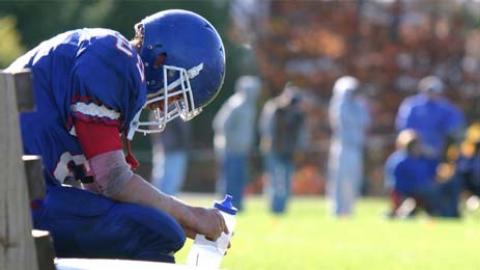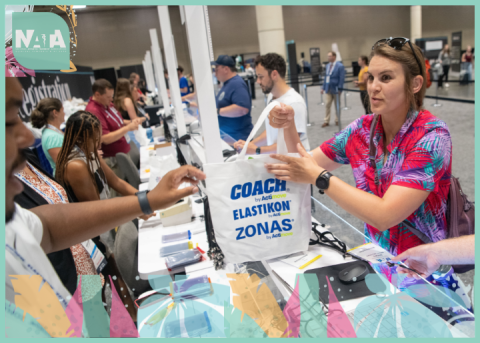
When we hear about catastrophic injury and death amongst athletes, we typically think about concussion1, cardiac arrest2 and exertional heatstroke3. Exercise-associated hyponatremia (EAH) is rarely mentioned alongside the “big three”, despite its insidious extension into more diverse sporting events beyond the ultramarathon, where it was first described three decades ago4. The recent and tragic deaths of two otherwise healthy 17-year old high school football players from hyponatremic encephalopathy5,6, underscores the need for more education towards translating evidenced-based science into clinical practice. All EAH deaths are tragic because they are unnecessary and preventable. The single greatest risk factor for EAH and its associated complications is over-hydration4. Although severely symptomatic hyponatremia is relatively rare, the evidence supports that death from EAH is avoidable if athletes adhere to rational hydration strategies and avoid excessive and unneeded fluid intake7.
Nearly a decade ago, the perils of over-hydration during exercise were confirmed in two seminal studies performed on 488 Boston Marathon runners8 and 2,135 endurance athletes7. These reports followed the back-to-back deaths of two female marathon runners in 2002 from EAH9. Subsequently, an international group of experts consolidated the existing evidence that strongly suggested that hyponatremia resulted from sustained or exuberant fluid intake beyond the body’s maximal fluid excretion rates (i.e., fluids consumed above the dictates of thirst or delivered intravenously)10. But despite strong evidence to the contrary, sporting culture continues to embrace hyper-hydration, with yet another pair of fatal outcomes as a result of this misinformation.
American football players are noted for their high sweat rates (often >2 liters/hour) due to large body surface area, protective equipment and intensity of play11. American college football players’ fluid consumption can exceed 12 liters per day. Given this, high fluid intake has become indoctrinated within football culture. For example, 75% of athletic trainers reported administering pre-game intravenous fluids to professional football players12. A college football player recently developed hyponatremia after receiving five liters of intravenous fluids while ingesting 3 additional liters of hypotonic fluid (a sports beverage) within five hours13. One of the high school athletes who died this year reportedly drank 16 liters of fluid during practice to alleviate muscle cramps5, despite recent experimental evidence suggesting severe dehydration does not impact cramp susceptibility14. Thus, while solid evidence published in a breadth of scientific journals clearly warn against the perils of hyper-hydration during exercise, responsible drinking during exercise has yet to be effectively translated onto the playing field. While concerns regarding dehydration and exertional heatstroke are valid, this occurrence is also rare. Current recommended safe drinking guidelines, advising athletes to drink to the dictates of thirst take all of these risks into account, such that extreme hydration is never warranted and the adverse effects can be avoided 10 .
In 2014, it is clear that EAH is preventable. We can control the amount of fluid that enters our body and must reconsider, re-educate and reinforce appropriate fluid intake and intravenous fluid guidelines10. The recent preventable deaths of two young football players (as well as several others in the recent past) should serve as a tragic reminder that medical personnel, professional societies and industry must strive harder to translate evolving scientific recommendations and guidelines to practical use by athletes and those who train them.
Signed,
Mitchell H. Rosner; University of Virginia Health System, Charlottesville VA
Tamara Hew-Butler; Oakland University, Oakland MI
Sandra Fowkes-Godek, PhD, LAT, ATC: West Chester University, West Chester PA
Martin D. Hoffman; University of California Davis Medical Center and VA Northern California Health Care System, Sacramento, CA
Douglas Lewis; University of Kansas School of Medicine-Wichita; Wichita, KS
Ronald J. Maughan: Loughborough University, UK
Kevin C. Miller, PhD, ATC: Central Michigan University, Mt. Pleasant MI
Scott Montain: US Army Research Institute of Environmental Medicine, Natick MA
Nancy J. Rehrer: University of Otago, NZ
William O. Roberts: University of Minnesota School of Medicine, Minneapolis MN
Ian R Rogers: St John of God Murdoch Hospital & University of Notre Dame, Australia
Arthur J. Siegel: Harvard Medical School, Boston MA
Dale Benjamin Speedy: Sportscare Auckland, New Zealand
Kristin J. Stuempfle: Gettysburg College, Gettysburg PA
Joseph G. Verbalis: Georgetown University Medical Center, Washington DC
James Winger: Loyola University Chicago Stritch School of Medicine, Chicago IL
Editor's Note: If you're interested in learning more about this topic, the HEAT Institute at West Chester University is organizing a free conference on exercise-associated hyponatremia on Feb. 20, 2015 at the Park Hyatt Aviara Resort in Carlsbad, California. Learn more here.
References
-
Guskiewicz KM, McCrea M, Marshall SW, Cantu RC, Randolph C, Barr W et al. Cumulative effects associated with recurrent concussion in collegiate football players: the NCAA Concussion Study. JAMA 2003; 290(19):2549-2555.
-
Kim JH, Malhotra R, Chiampas G, d'Hemecourt P, Troyanos C, Cianca J et al. Cardiac arrest during long-distance running races. N Engl J Med 2012; 366(2):130-140.
-
Yankelson L, Sadeh B, Gershovitz L, Werthein J, Heller K, Halpern P et al. Life-threatening events during endurance sports: is heat stroke more prevalent than arrhythmic death? J Am Coll Cardiol 2014; 64(5):463-469.
-
Noakes TD, Goodwin N, Rayner BL, Branken T, Taylor RK. Water intoxication: a possible complication during endurance exercise. Med Sci Sports Exerc 1985; 17(3):370-375.
-
Stevens A. Update: Douglas County football player has died. The Atlanta Journal-Constitution 14 A.D. Aug 11.
-
Blevins R, Apel T. Preps Sports Report. The Clarion-Ledger 2014 Aug 27.
-
Noakes TD, Sharwood K, Speedy D, Hew T, Reid S, Dugas J et al. Three independent biological mechanisms cause exercise-associated hyponatremia: evidence from 2,135 weighed competitive athletic performances. Proc Natl Acad Sci U S A 2005; 102(51):18550-18555.
-
Almond CS, Shin AY, Fortescue EB, Mannix R, Wypij D, BinstadtBA et al. Hyponatremia among Runners in the Boston Marathon. N Engl J Med 2005; 352(15):1550-1556.
-
Siegel AJ, Verbalis JG, Clement S, Mendelson JH, Mello NK, Adner M et al. Hyponatremia in marathon runners due to inappropriate arginine vasopressin secretion. Am J Med 2007;
-
Hew-Butler TD, Ayus JC, Kipps C, Maughan RJ, Mettler S, Meeuwisse WH et al. Statement of the Second International Exercise-Associated Hyponatremia Consensus Development
-
Godek SF, Bartolozzi AR, Godek JJ. Sweat rate and fluid turnover in American football players compared with runners in a hot and humid environment. Br J Sports Med 2005; 39(4):205-211.
-
Fitzsimmons S, Tucker A, Martins D. Seventy-five percent of National Football League teams use pregame hyperhydration with intravenous fluid. Clin J Sport Med2011; 21(3):192-199.
-
Herfel R, Stone CK, Koury SI, Blake JJ. Iatrogenic acute hyponatraemia in a college athlete. Br J Sports Med 1998; 32(3):257-258
-
Braulick K, Miller K, Albrecht J, Tucker J, Deal J. Significant and serious dehydration does not affect skeletal muscle cramp threshold frequency. Br J Sports Med. 2012;47:710-4.





